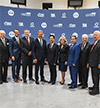- Manufacturing grew in December 2013 at the second-fastest pace in more than two years.
- ISM’s factory index averaged 51.5 in the first six months of 2013 and 56.3 in the second six months (values over 50 indicate an expansion).
- ISM’s inventory index decreased to the lowest level since July 2013.
- Consumer confidence is the highest it has been in six years.
- Europe’s economy is emerging from its long recession
Manufacturing purchasing and supply executives also expect to see continued growth. “They are optimistic about their overall business prospects for 2014," says Bradley Holcomb, chair of the ISM Manufacturing Business Survey Committee. "Our forecast calls for a continuation of growth in 2014, building on the momentum from the second half of 2013. Respondents also expect raw materials pricing pressures in 2014 to be low and their margins to improve."
A Welcome Reversal
“Reshoring” is a real phenomenon — U.S. companies are coming back from low-cost countries and hiring American workers. According to figures provided by the Reshoring Initiative, from 2003 to 2013 offshoring jobs dropped by 70 percent, whereas new reshoring jobs grew by +1,500 percent!
“About 150 companies became reshorers in 2013,” says Harry Moser, founder of the Reshoring Initiative. “Since January 2010 about 100,000 U.S. jobs have been created by companies that brought their operations back to this country.”
“The U.S. lost manufacturing jobs over the last two decades due to globalization,” says Kurt Bauer, president of Wisconsin Manufacturers & Commerce in Madison. “Emerging economies in Asia had cheaper labor and fewer regulations, which made offshore production a necessity to stay competitive. However, labor costs are now rising in nations like China.”
Other key factors bringing back U.S. production are abundant and lower-cost energy, lower transportation costs, and better protection against counterfeiting, piracy, and theft of trade secrets.
John H. Boyd, principal with the Boyd Company, a site selection firm in Princeton, N.J., predicts a significant number of production, final assembly, and quality control jobs will return to the U.S. over the next decade, driven also by “the expanded compliance arenas coming under review by government agencies like the FDA and FAA for new interactive, wireless technologies, including the high-growth, med-tech IT sector.” U.S. manufacturers coming out of the Great Recession had become very lean and efficient, which resulted in higher productivity...Even though manufacturers have used automation to be competitive, they still need skilled and motivated people. Kurt Bauer, president of Wisconsin Manufacturers & Commerce
“Quality concerns are a big reason higher-value and more technical products are looking to come back to the U.S. or nearby in Mexico,” agrees Larry Gigerich, managing director for Ginovus, a location consulting firm based in Indianapolis. “The lack of intellectual property protection in some locations has become a large problem. There is also more momentum for reshoring in the areas of customer care/technical support and financial services.”
An overall improving business climate in the U.S. — especially regarding positive labor-management relations — is also a big motivator. “Right-to-work states will have a competitive advantage for many of these reshoring projects,” adds Boyd. “Indiana and Michigan’s historic move to right-to-work status represents a telling adjustment to this well-established trend.”
Tightening the Supply Chain
The supply chain has everything to do with the profitability of manufacturing operations. It allows a company to be lean and efficient, which translates into better productivity and competitiveness. Better control of their supply chains is another big reason companies are coming back to the U.S.
“Supply chain management includes sourcing, operations/manufacturing, inventory management, logistics, and customer service,” indicates Douglas Fisher, director of the Center for Supply Chain Management at Marquette University in Milwaukee. “Companies are returning to the U.S. because they are tired of dealing with long, inflexible supply chains. For example, it might take months when sourcing from China. Related realities include dealing with large inventories, slow response times to market changes, and more severe impacts from disruptions like port strikes or natural disasters.”
Companies are also streamlining their supply chains, cutting out vendors that don’t deliver their absolutely best effort, every time. “Companies that survived the Great Recession have a much shorter tolerance for mistakes or inconsistent performance,” says Drew Greenblatt, president of Marlin Steel Wire Products in Baltimore, Maryland. “Companies also don’t want to tie up cash or space for inventory. Therefore, supply chain partners must be more efficient and flexible in the services they provide.”
ISM indicates that supply chain managers in 2014 will be focusing on improvements such as strategic sourcing/supply base rationalization, process and information systems, supplier relationship management, inventory management and control, and improved cross-functional planning.
With shipping representing the single-largest cost factor in the supply chain, and rising fuel and trucking costs a big concern, Boyd suggests that manufacturers should consider “locating production facilities as close to intermodal rail ramps as possible, thus providing opportunities to reduce dependence on over-the-road transport and achieve a greater utilization of lower-cost rail.”
Regional Leaders
San Antonio, El Paso, Atlanta, Charlotte, Indianapolis, Mobile, Oklahoma City, Louisville, Memphis, and Nashville are among those locations enjoying a manufacturing surge, according to Gigerich. “Business climate, location, economic development incentives, infrastructure, and human capital quality/costs are all driving growth in these areas,” he adds.
Boeing's decision to manufacture the 777X in the Puget Sound has made the state of Washington a key location for U.S. composite manufacturing. BMW is already producing composite parts for its new generation of more fuel-efficient vehicles in Moses Lake. “The use of lightweight, strong composites is also rapidly expanding into other manufacturing sectors like motor vehicles, appliances, consumer electronics, and recreational products,” says Boyd. Quality concerns are a big reason higher-value and more technical products are looking to come back to the U.S. or nearby in Mexico...The lack of intellectual property protection in some locations has become a large problem. Larry Gigerich, managing director for Ginovus
Industries that consume natural gas as a feedstock or energy source — especially chemicals and plastics manufacturers — are locating in states like Pennsylvania, Ohio, and West Virginia where hydraulic fracturing has generated vast natural gas supplies. For example, because of the inexpensive supply of regionally produced natural gas around Pittsburgh, this manufacturing city is experiencing a surge in chemical production. “Low-cost energy supplies coming on stream in states like Pennsylvania are enabling states in the Northeast to effectively compete with energy-rich Gulf Coast states like Louisiana for new chemical and plastics industry investment,” says Boyd.
Aerospace manufacturing is also looking good, thanks to the FAA’s NextGen and UAV (drone) programs — both multibillion-dollar programs. NextGen will convert the country’s air-traffic control system from radar-based to satellite-based. For the UAV program, the FAA recently awarded special test-site status to Alaska, Nevada, North Dakota, Texas, New York, and Virginia. Boyd indicates that Florida, Arizona, Alabama, and New Mexico are also well positioned to attract new drone investment, especially in the electronics, avionics, and metal products sectors.
Moving Forward
Manufacturing companies made significant capital investments during the recession to lower operating costs and prepare for the economic recovery. “Many companies invested in automation to increase operational efficiency,” says Gigerich. “This allowed them to be more productive, while lowering or maintaining headcount.”
Greenblatt indicates that Marlin Steel Wire Products recently invested $3.5 million in new equipment and robotic technology. “Robots make better-quality parts,” he says. “The robots are inside the cage, doing the nasty, carpal-tunnel work. This allows our employees to do safer, more challenging work.”
Robots and automation can therefore provide critical relief to workers, who were often pushed to the limit during the Great Recession. By improving the comfort and safety of the workplace, companies can retain their most skilled and creative employees. This is a huge concern, considering the fact that the lack of qualified workers, i.e., the “skills gap,” is the greatest threat to U.S. manufacturing today.
“U.S. manufacturers coming out of the Great Recession had become very lean and efficient, which resulted in higher productivity,” says Bauer of Wisconsin Manufacturers & Commerce. “Even though manufacturers have used automation to be competitive, they still need skilled and motivated people.” ISM data show the manufacturing sector closed out 2013 with seven straight months of expansion..Three big reasons for this transformation are the recession, lower energy costs driven largely by natural gas, and rising labor costs in China. Mitchell Higashi, chief economist for GE Healthcare in Milwaukee, Wisconsin
According to research from the Society of Human Resource Management, most manufacturers are hiring, but 67 percent of those companies looking for full-time employees can’t find individuals with the skills they need. “Research conducted by the National Association of Manufacturers (NAM) seconds this reality,” states Adam Beckerman, partner in charge of the Manufacturing and Distribution Group for Habif, Arogeti and Wynne in Atlanta. “NAM discovered that 600,000 jobs go unfilled in the industry because of a lack of necessary skills, despite the country’s current unemployment rate.”
The skills gap isn’t expected to close any time soon, Beckerman points out. NAM’s research indicated that 56 percent of respondents expect the shortage to grow even worse in the next three to five years. “To turn this trend around, states and communities need to rally behind vocational schools and encourage students to look into trade skills,” advises Beckerman.
In Pennsylvania, for example, Governor Tom Corbett established the Pennsylvania Targeted Industry Program to provide financial aid grants to meet work force needs. So far, grants have been given to over 1,200 students enrolled in certification programs in high-demand industries such as energy, advanced materials, diversified manufacturing, and agriculture and food production. The state has also partnered with the Manufacturers Resource Center, a nationally recognized leader in manufacturing assistance, to launch a “Skill Up” initiative to help change the image of manufacturing and encourage careers in modern manufacturing.
To maintain global competitiveness as a manufacturer, Higashi recommends finding new and innovative ways to generate productivity and efficiency, as well as investing when opportunity arises. For example, GE Aviation recently broke ground on a new 170,000-square-foot facility in Asheville, N.C., that will be the first in the world to mass-produce engine components made of advanced ceramic-matrix composite materials. Because this is the first time these components are being mass-produced anywhere in the world, an advanced training program was developed in partnership with Asheville-Buncombe Technical Community College (ABTCC).
Developing a talented work force is critical for any expansion into a new market. “Competency always trumps cost,” says Higashi. “While factors like wage rates and foreign exchange rates can change over time, high-paying manufacturing jobs tend to follow a skilled, creative work force. Our success in Asheville is a great example of how innovation, supported by strong teaching institutions and local governments, can translate into good-paying manufacturing jobs.”



